
Deeply Expanded Reality
of Aphotia by Emilija Škarnulytė as a harbinger of the Vilnius Biennial of Performance Art
Emilija Škarnulytė is an unquestionable star of the Lithuanian art scene, even a planet with its own aesthetic canons, rituals and atmospheric “sound” that is intrinsic to much of her work. More than anything, her films resemble deep dives into parallel universes that are in some ways similar and in others totally different from the world we know. She easily mixes documentary and fiction, camera footage and computer-generated images. The artist says she often finds inspiration in non-human: geology, landscape and other spatial phenomena that bring her closer to the perception of a different type of time flow, the so-called deep time. “Equally important to me is the figure of the mermaid or the siren, as a link between the known and the unknowable world; the divide between human, animal, deity, and myth”. A mermaid is sometimes the only inhabitant of Škarnulytė film spaces, she slides in the water, diving into spacious dark underwater corridors, like a flashlight of an inexhaustible fantasy, illuminating spaces usually inaccessible to the eye.
Emilija Škarnulytė at the first part of the performance 'Aphotia'. Photo: Andrej Vasilenko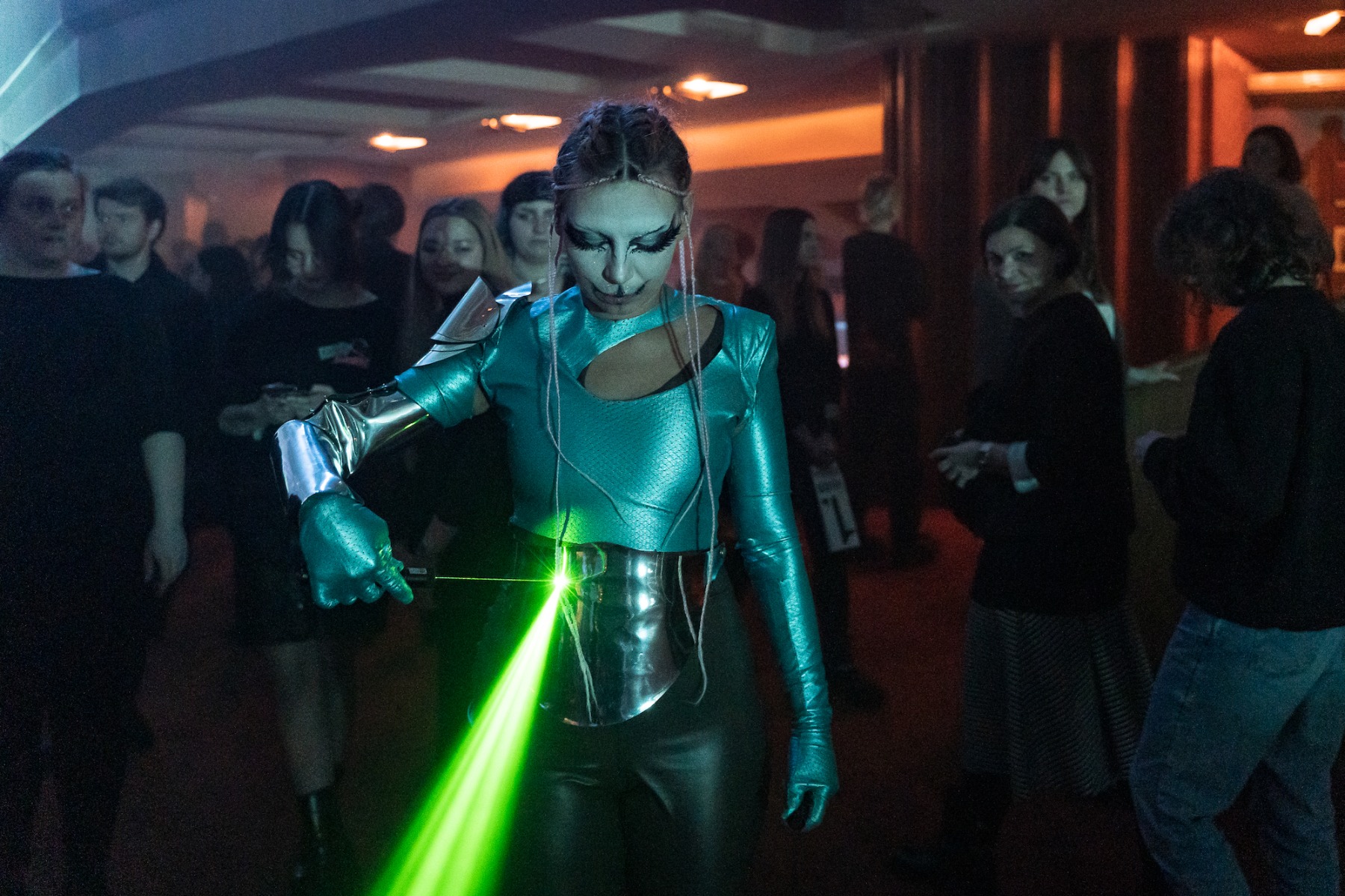
Emilija says that in her works “she uses extended sensitivity – deep sea shootings, sounds usually inaudible to the human ear”. The medium of the film allows her to combine all this into a “signal” that forms a new specific type of sensitivity: “What was most important to me while making these films was not a particular place or phenomenon, but the formation of an unusual, distorted perception of space and time, which can evoke a very special spiritual state. In order to empathise with a grandmother’s lack of sight, or to see a lost city or radiation, you need to give up your personal gaze” – says the artist in her interview to Rosana Lukauskaitė.
In her artistic practice Emilija often reflects upon the problem of human influence on natural landscapes and not only the underwater ones, but there is no post-apocalypse doom in her work. The world she reveals in her works is both natural and constructed: the robots working at the bottom of a sea are not so different in their manners from natural inhabitants of this locale. At the same time, the artist masterfully works with site-specific presentation of her films: “My video installations function as landscapes that viewers can physically enter”.
Photo: Gintarė Grigėnaitė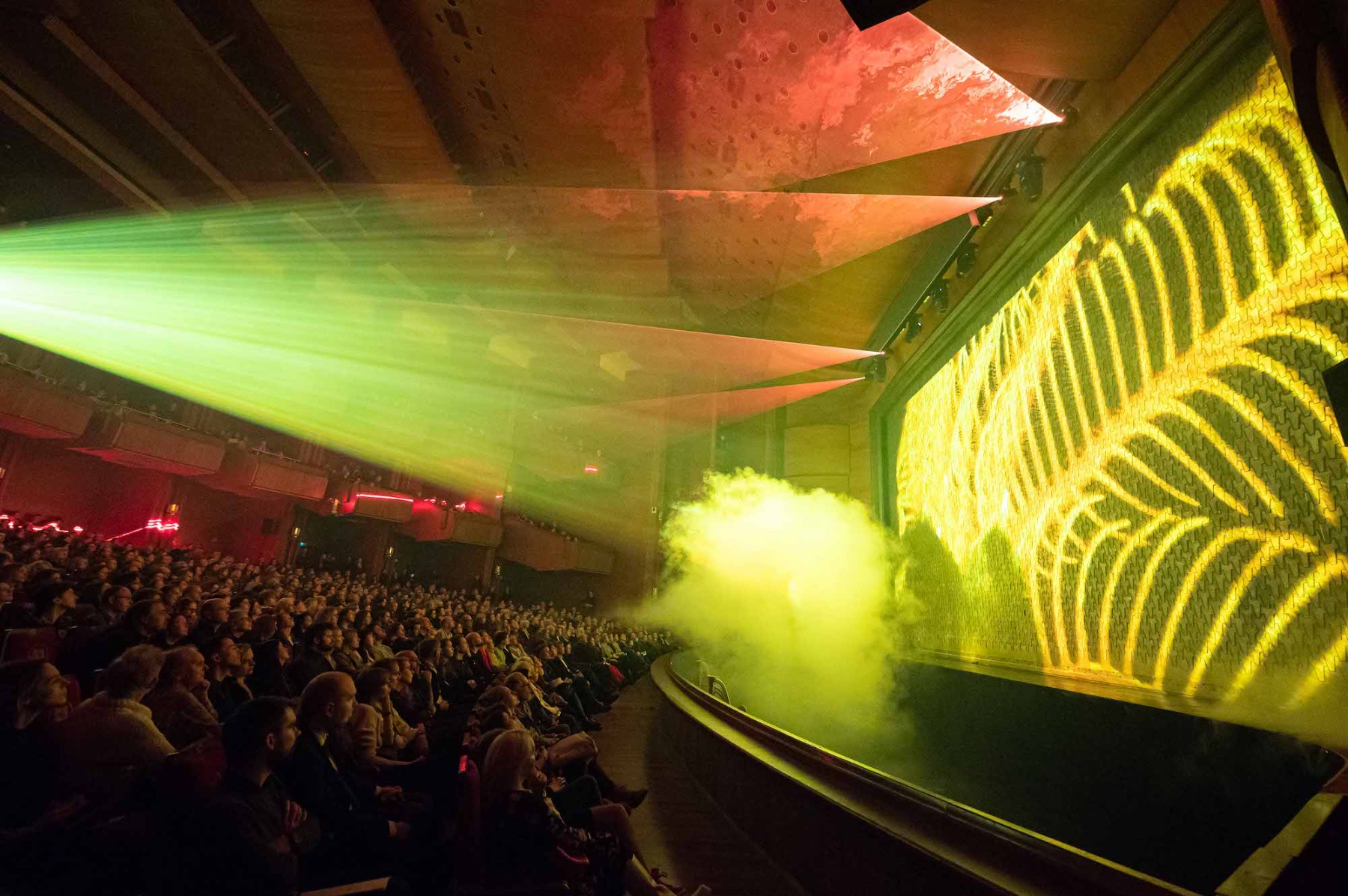
The Vilnius Biennial of Performance Art, organised by the local gallery “Meno Niša" – one of the important events of Vilnius 700th anniversary celebration – gave Emilia the opportunity to expand her video installation to a performance involving a large number of actors, and at the same time to revive one of the city’s most amazing spaces. The main building of the Lithuanian National Theatre of Opera and Ballet is a powerful and impressive example of late architectural modernism, with a total volume of 120.5 thousand. m³. It remains the most large-scale cultural building in Vilnius. Built on a hill and rising above the surroundings, it gives an impression of a modernist temple.
Photo: Andrej Vasilenko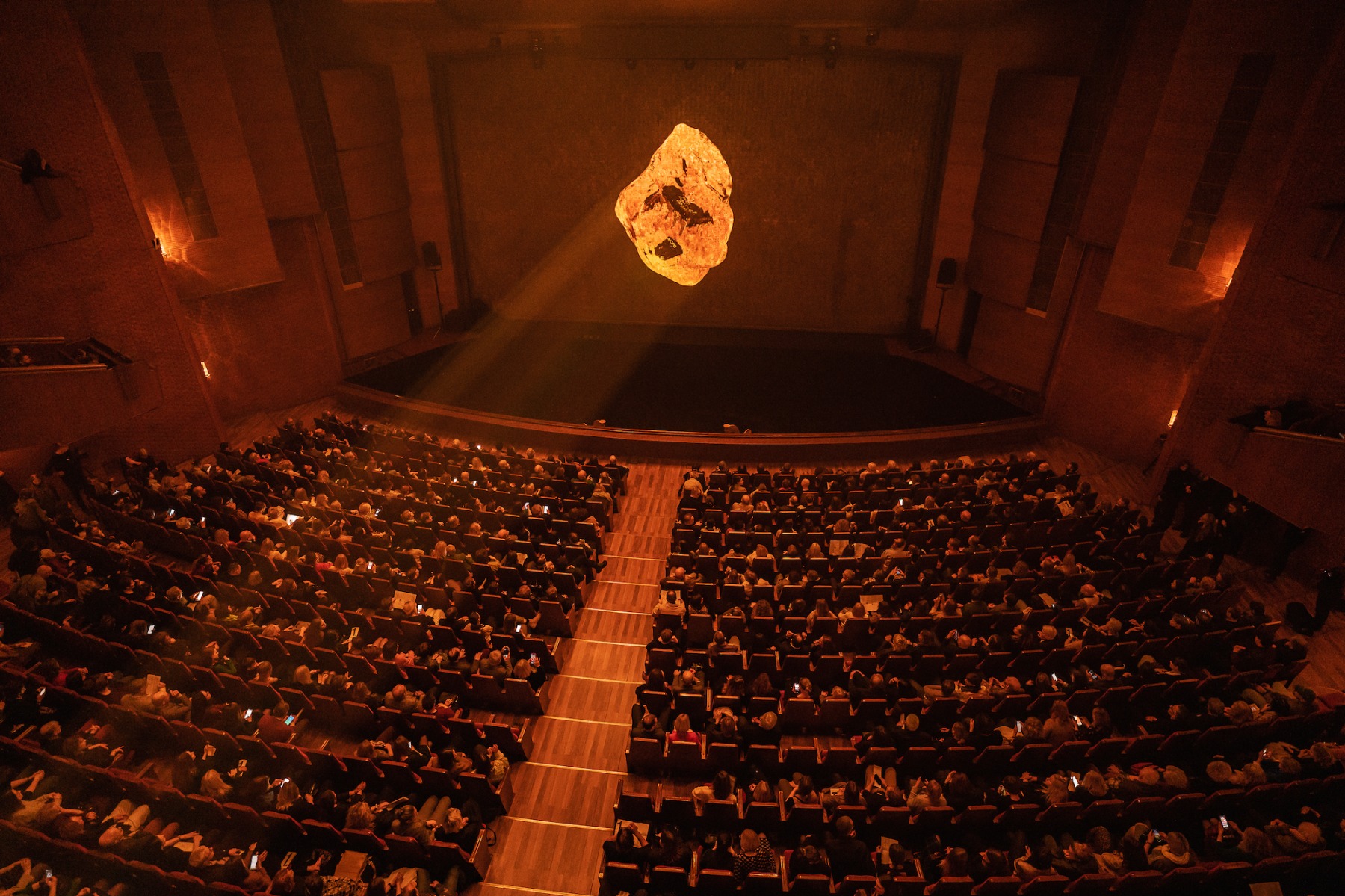
The idea of this building belongs to the Lithuanian architect Elena Nijolė Bučiūtė. It was her project that won the competition in 1960 and was implemented by 1974. At that time the project generated much discussion, and, defending her brainchild, the architect turned to her own childhood impressions of the cross processions in the yard of the red brick neo-Gothic church in her native town of Rokiškis. In an article dedicated to the “personal modernism Bučiūtė”, Indrė Ruseckaitė and Lada Markejevaitė write: “According to the architect, she had never felt any discomfort while going around such huge brick walls. On the contrary, she could feel strong, solemn, being in extraordinary spirits: the powerful brickworks of the church (similar to the volume of the OBT auditorium), the surrounding open space of the churchyard (analogous to the panoramic view of the city opening through the glazed walls of the lobby) and the high sky (very much like the ceiling panel of the lobby practically vanishing in its twelve metre height) generated the convivial character of the space”.
Emilija Škarnulytė admits that her performance Aphotia, presented in Vilnius on the evening of January 23, was largely inspired by the very architecture of the theatre building, designed by Elena Bučiūtė. “The performance functions in an active relationship with this architect’s work and becomes an act of homage to this space. The piece involves the spaces from the entrance and foyer to the theatre’s main hall, providing the opportunity to rethink how this building functions and think in layers”.
Photo: Marius Zucius
But if Bučiūtė sort of stretched the vertical of her architectural narrative upwards, Škarnulytė plunged this entire structure and the audience into imaginary depths, turning the building upside down and projecting it onto the ocean floor. The playbill distributed at the entrance featured the performance scenario with depth gradation: the first part was to take place in the lobby at a depth of 200-2000 m, then we were to move to the so-called “red lobby” at 2000-6000 m, and the final action occupied the main theatre hall at 6000 m and deeper.
“In Aphotia, I look into the layers of the ocean – its surface and what lies beneath it. This translates into the structure of the work, which becomes a three-part journey into the depths of the oceans, with differences in temperature, oxygen content, forms of life, etc.” – says the artist. “The title of the piece is based on the term ‘aphotic zone’, also known as ‘dark ocean’ – the depths of the ocean that are inaccessible to sunlight. In the summer of 2022, Škarnulytė’s video work with the same title was presented at an exhibition in Venice. The new title created for the one-time performance at LNOBT personifies the term, combining aspects of nature, deity, man and animal, and unfolding a special medium for mixed forms of being to coexist” – says Neringa Bumblienė, artistic director for the Vilnius Biennial of Performance Art. It’s not only the depths of the oceans we are talking about, but also the depths of human consciousness, where the time flow can also slow down, or rather change the pace and the intensity of how we experience time.
Photo: Andrej Vasilenko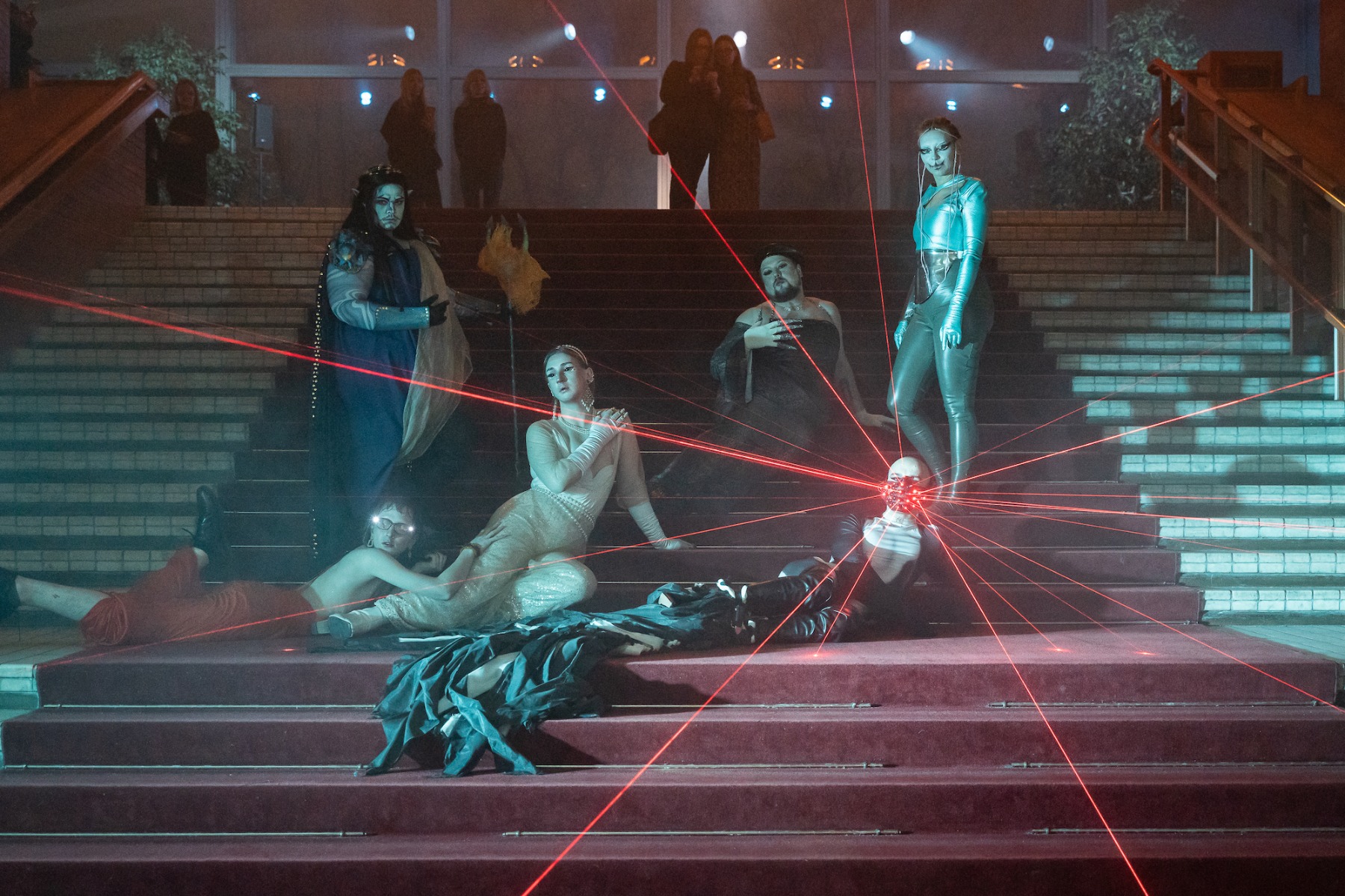
Photo: Andrej Vasilenko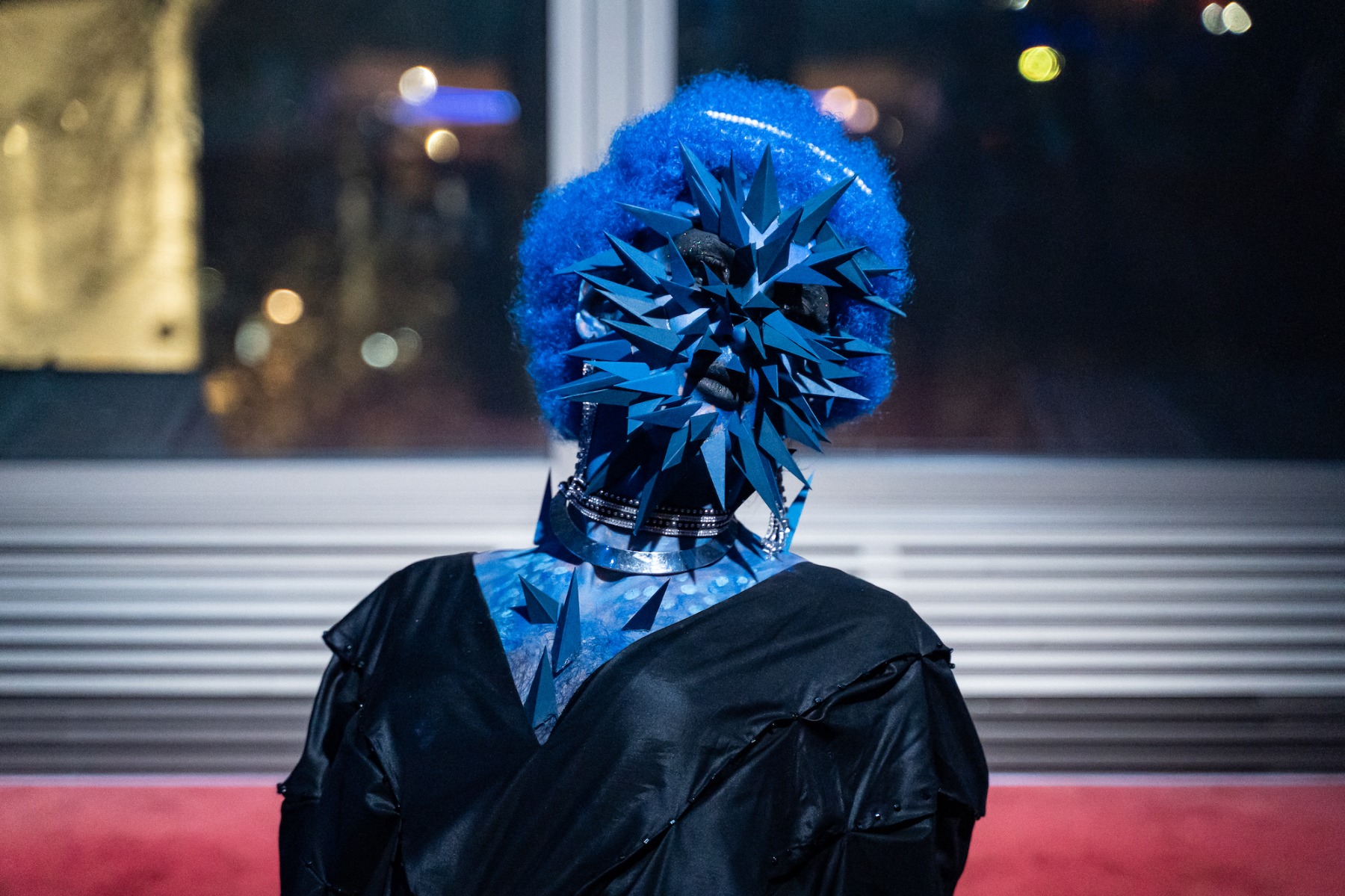
On the evening of the performance, the visitors were met by the “inhabitants of the sea” in the lobby of the theatre – alternatively moving and frozen figures dressed in retro-futuristic costumes of mermaids and other underwater creatures. They mingled with the crowd, moving through slowly and with a certain degree of posing. The first part of the performance surprisingly resembled one of the Assemblies of Untamed Fashion in Riga. Its producers often used late Soviet modernist buildings, like Riga Congress Hall constructed in 1982, as venues for their performances. The soundtrack to the event was created by Emilija Škarnulytė together with composer Suzanne Kait; the ambient sound vibrated as if the building itself, its very structure was vibrating. As the intensity of the action grew, the underwater figures were joined by a chorus in black hoods, spilling out onto the platform above the lobby. The singing was building up in volume to almost a thunder, then subsided to hush as if expanding, rhythmizing the whole space covered in “deep” light projections. Then a set of doors opened inviting the audience to the main theatre hall. The seats taken, Emilija’s film was projected onto a giant fish scale like backdrop-screen. The artist herself appeared on the stage as a mermaid, of course, to sing along the screening accompanied by two harpists. The projection was sometimes supported by masses of laser lights, creating a whole new visual layer, which at the end of the performance descended on the auditorium, then rose up, as if immersing the audience in the performance, illuminating and slightly blinding them.
At the second part the underwater figures were joined by a chorus in black hoods. Photo: Gintarė Grigėnaitė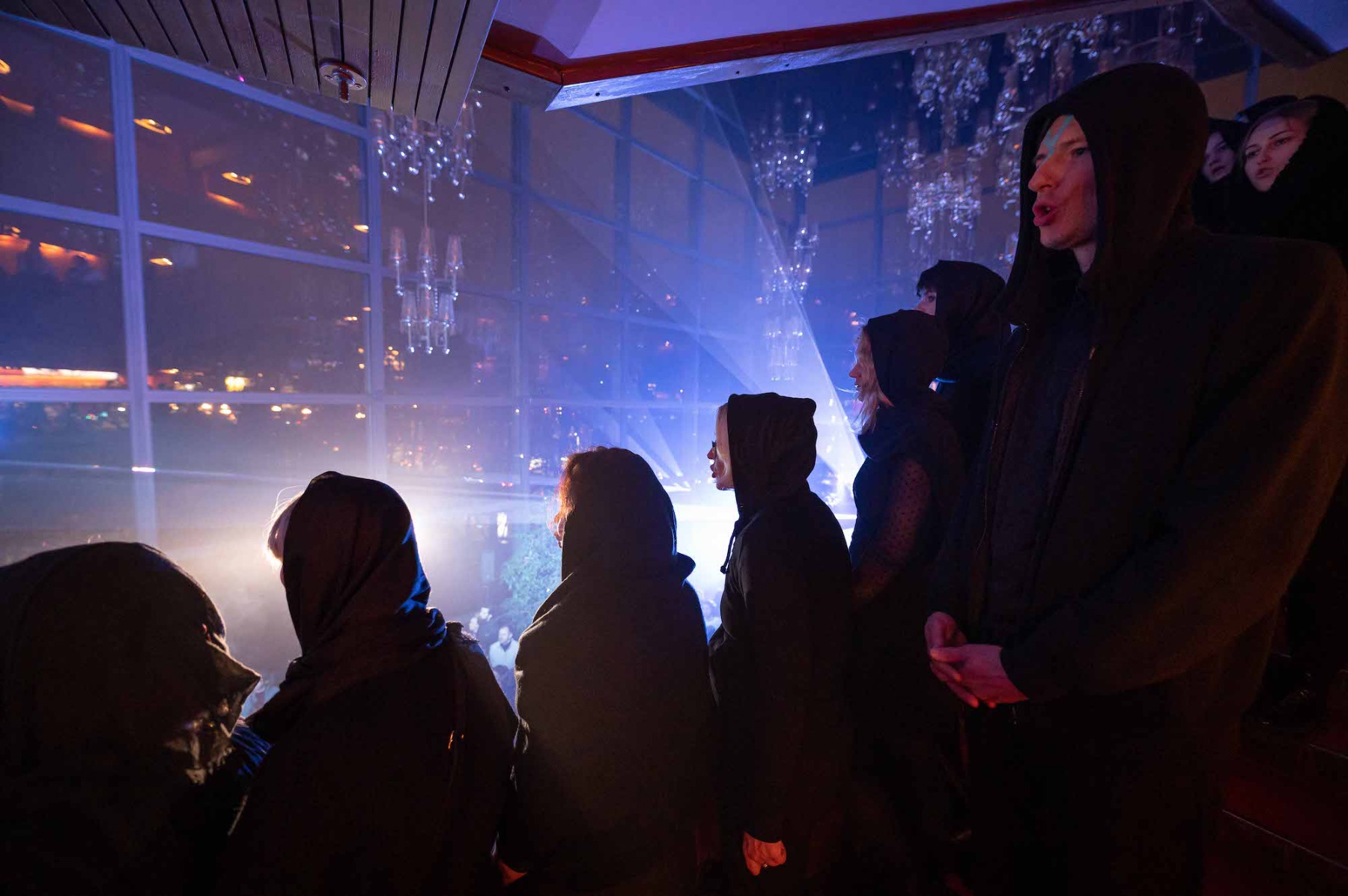
Photo: Gintarė Grigėnaitė
Photo: Gintarė Grigėnaitė
The scaly screen gave volume and blur to the projected image, merging documentary footage and computer animation up to the point of distinguishability. The temple-like architectural “sound” of the building itself, the sound of music and the scale and depth of video projections, the laser light waves – all of these combined created a general feeling of a powerful ritual, which at the same time featured an element of aimless wandering in the unlimited space of dreams/fantasies/visions. Like an eye sliding over things, the mermaid (a human figure in a costume, Emilija herself) glides over the images projected on the screen behind her; like a child with her head thrown back may wander along a church which would appear to her even more gigantic considering her size. Perhaps, a prototype of a future temple appeared (loomed) here, a temple where all natural and anthropocentric forms of existence will finally come together peacefully.
Photo: Marius Zucius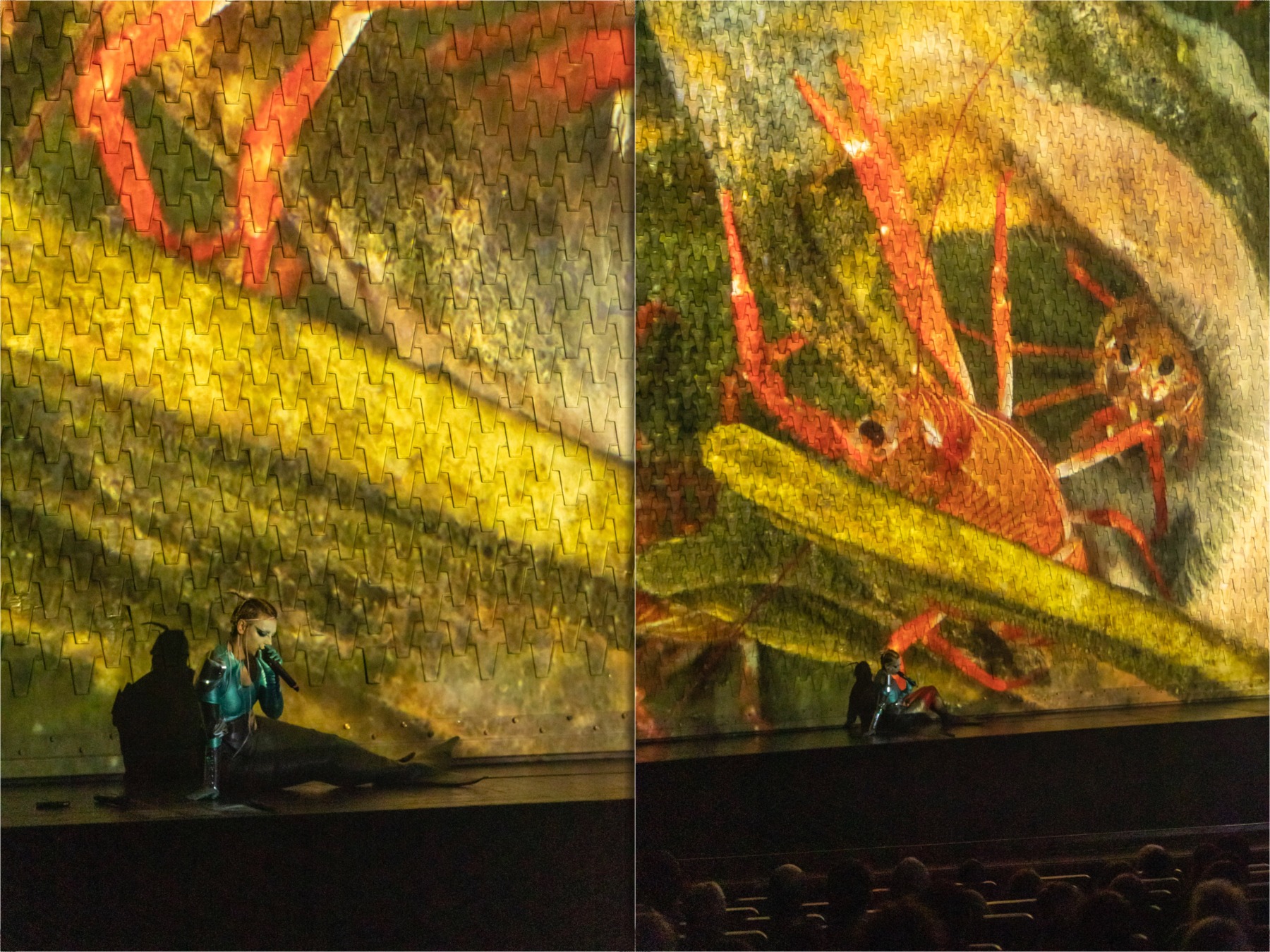
Photo: Marius Zucius
A wonderful addition to the performance is the Emilija Škarnulytė exhibition which opened in February 2022 and will last for another year (!) in the Radvilas Palace – a new art space in Vilnius, located in a mid 17th century building). The show is titled Chambers of Radiance and is centred around “t ½” – one of the artist’s most famous works, which brought her the international Future Generation Art Prize in 2019, a biennial award launched in Kiev by PinchukArtCentre. I went to see the show the next morning, being one of the very few visitors of the palace, and it came as a striking contrast with the crowded theatre with its capacity of 1147 seats. Lying on a futuristic foam couch, as if cut out by a pair of straight lines, my eyes wandering over a looped video (with no clear beginning or end), I could feel like a pilot of some spaceship or underwater vessel, calmly and confidently moving through the waves of the unknown.
Photo: Gintarė Grigėnaitė
Photo: Gintarė Grigėnaitė
Emilija Škarnulytė is one of the most internationally sought-after Lithuanian artists. This year her works will appear at the Henie Onstad Triennial in Oslo, the Gwangju Biennale in South Korea, a personal exhibition in Zion (Switzerland), the Helsinki Biennale, the Ars Fennica 2023 exhibition at the Kiasma Museum of Modern Art in Finland, and the Ljubljana Biennale. This level of demand can be due to emphasised spectacularity of her art, open to the most diverse audiences, which at the same time is absolutely “non-superficial”. The artist is infatuated with depth in many ways.
Aphotia performance added some new dimensions to her depth, allowing the people of Vilnius to feel and experience one of the iconic buildings of their city in a new way. After all, the attempt to rethink the city space is the most important mission stated by the Vilnius Biennial of Performance Art, the key events of which will unfold at the end of this summer from July 23 to August 6.
Photo: Andrej Vasilenko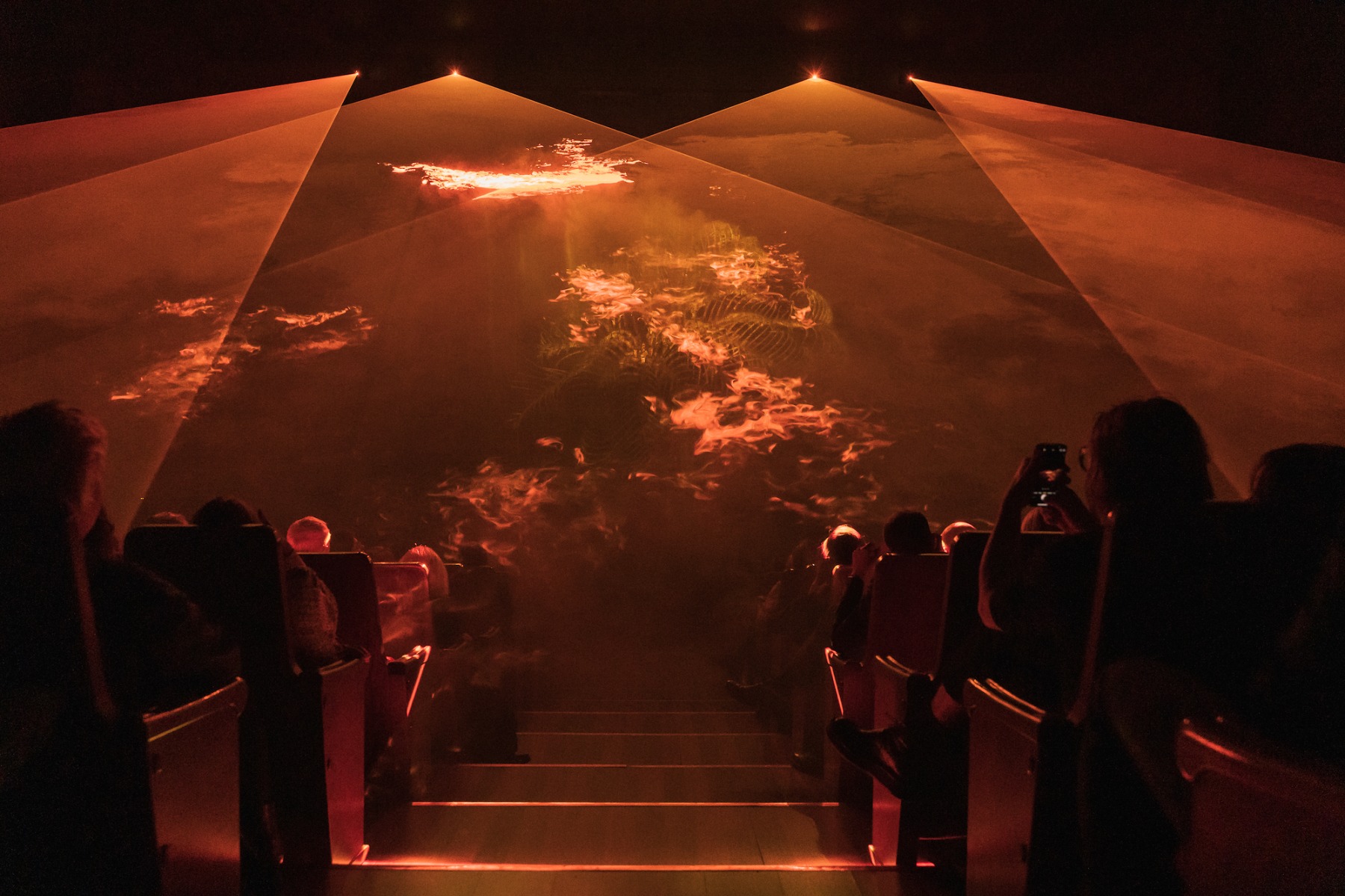
“When I was invited to become the artistic director of the Biennial, it took me some time to devise a suitable theme for the festival. Ultimately, I decided to focus on the city—as a human-made and human-dominated environment that we share with other species, where different histories, myths, activities, interests, desires, and visions overlap, coexist and collide”, – says Neringa Bumblienė, artistic director for the Vilnius Biennial of Performance Art.
Photo: Andrej Vasilenko
Aphotia live performance turned out to be a collision of scales – epic and funny, technological and human. When, at the end of the performance the wall of red laser light which sometimes had descended on the auditorium mesmerising it, rose up, the mermaid (Emilija Škarnulytė herself) came down from the stage to the audience without a microphone and walked past the rows saying “It’s over, it’s over!”. The audience responded with applause. The Vilnius Biennial of Performance Art fantasia took its first preliminary shape. And thanks to the ideas and unique creative vision of Emilija Škarnulytė it has expanded in depth. We are about to see what other dimensions the biennial will open for us in just a few months of 2023.